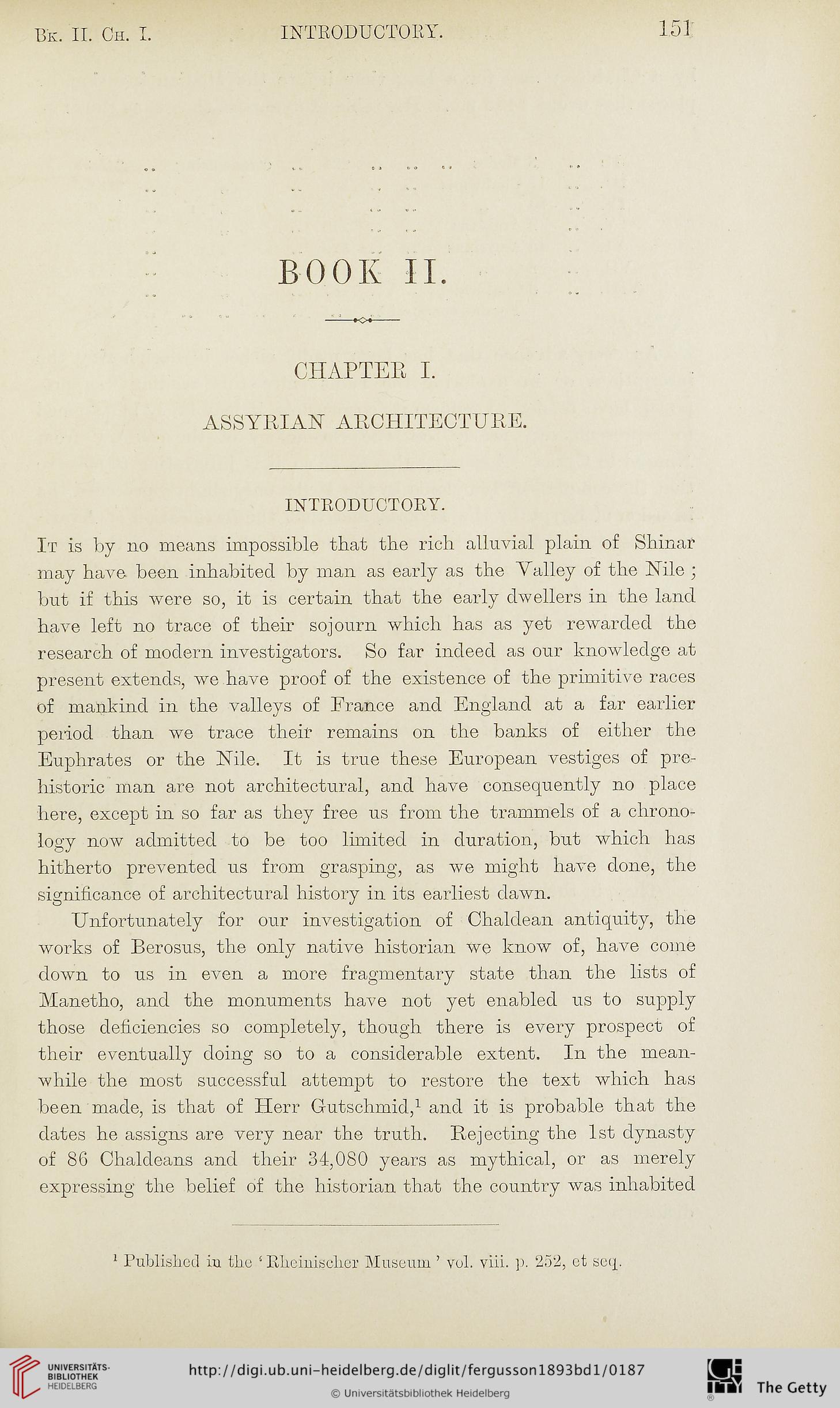Bfc. II. Ch. I.
introductoky.
151
BOOK II.
CHAPTEE I.
ASSYRIAN ARCHITECTURE.
INTEODUCTOEY.
It is by no means impossible tbat the rich alluvial plain of Shinaf
may have been inhabited by nian as early as the Valley of the Nile ;
but if this were so, it is certain that the early clwellers in the lancl
have left no trace of their sojourn which has as yet rewardecl the
research of moclern investigators. So far incleed as our knowledge at
present extencls, we have proof of the existence of the primitive races
of mankincl in the valleys of France ancl England at a far earlier
peiiod than we trace theif remains on the banks of either the
Euphrates or the Nile. It is true these European vestiges of pre-
historic man are not architectural, and have consequently no place
here, except in so far as they free us from the trammels of a chrono-
logy now aclmitted to be too limitecl in cluration, but which has
hitherto preventecl us from grasping, as we might have clone, the
significance of architectural history in its earliest dawn.
Unfortunately for our investigation of Chalclean antiquity, the
works of Berosus, the only native historian we know of, have come
down to us in even a more fragmentary state than the lists of
Manetho, and the monuments have not yet enablecl us to supply
those deficiencies so completely, though there is every prospect of
their eventually doing so to a considerable extent. In the mean-
while the most successful attempt to restore the text which has
been made, is that of Herr Gutschmid,1 ancl it is probable that the
dates he assigns are very near the truth. Rejecting the 1st clynasty
of 86 Chaldeans ancl their 34,080 years as mythical, or as merely
expressing the belief of the historian that the country was inhabited
Publislicd iu tliu ‘ EL.eimscb.cr Museum ’ vul. viii. p. 252, ct se(^.
introductoky.
151
BOOK II.
CHAPTEE I.
ASSYRIAN ARCHITECTURE.
INTEODUCTOEY.
It is by no means impossible tbat the rich alluvial plain of Shinaf
may have been inhabited by nian as early as the Valley of the Nile ;
but if this were so, it is certain that the early clwellers in the lancl
have left no trace of their sojourn which has as yet rewardecl the
research of moclern investigators. So far incleed as our knowledge at
present extencls, we have proof of the existence of the primitive races
of mankincl in the valleys of France ancl England at a far earlier
peiiod than we trace theif remains on the banks of either the
Euphrates or the Nile. It is true these European vestiges of pre-
historic man are not architectural, and have consequently no place
here, except in so far as they free us from the trammels of a chrono-
logy now aclmitted to be too limitecl in cluration, but which has
hitherto preventecl us from grasping, as we might have clone, the
significance of architectural history in its earliest dawn.
Unfortunately for our investigation of Chalclean antiquity, the
works of Berosus, the only native historian we know of, have come
down to us in even a more fragmentary state than the lists of
Manetho, and the monuments have not yet enablecl us to supply
those deficiencies so completely, though there is every prospect of
their eventually doing so to a considerable extent. In the mean-
while the most successful attempt to restore the text which has
been made, is that of Herr Gutschmid,1 ancl it is probable that the
dates he assigns are very near the truth. Rejecting the 1st clynasty
of 86 Chaldeans ancl their 34,080 years as mythical, or as merely
expressing the belief of the historian that the country was inhabited
Publislicd iu tliu ‘ EL.eimscb.cr Museum ’ vul. viii. p. 252, ct se(^.




